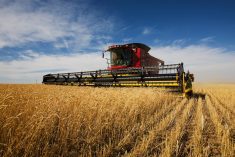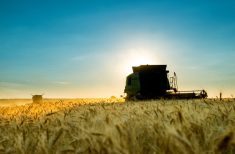CNS Canada – Thanks to good weather during the last half of October 99 per cent of Saskatchewan’s crop has been harvested according to Saskatchewan Agriculture’s final Crop Report of 2018. However, snow and rain in early November has delayed the harvest of the remaining crops such as flax and oats, but producers hope to be back combining once the weather improves. On many farms aeration bins and grain dryers have been in continuous operation for more than a month.
Despite difficult harvest conditions, producers were able to pull off average to above-average crop quality overall. Crops that came off prior to the rain and snow in September have been grading in the top two grades, while some crops that have recently come off have been downgraded due to weather-related factors such as sprouting, bleaching, staining and frost. There have been limited reports of diseases such as fusarium head blight and ergot affecting crop production this year.
Read Also

Senft to step down as CEO of Seeds Canada
Barry Senft, the founding CEO of the five-year-old Seeds Canada organization is stepping down as of January 2026.
Crop yields vary greatly across Saskatchewan because of the amount of moisture received throughout the season. Overall provincial yields are about par with the 10-year average, although many areas are reporting higher-than-expected yields thanks to timely rain. Yields in many southern and central areas were significantly affected by the hot and dry conditions this summer. Average provincial yields at this time are being reported as 43 bushels per acre for hard red spring wheat, 38 bushels per acre for canola, 22 bushels per acre for soybeans, 35 bushels per acre for field peas, 61 bushels per acre for barley, 1,236 lb. per acre for lentils and 1,153 lb. per acre for chickpeas.
Topsoil and subsoil moisture conditions have drastically improved with the recent snow and rain, but remain a concern in much of the province. Significant moisture will still be needed heading into winter to replenish what has been lost throughout the growing season. The subsoil is very dry and that growing conditions may be affected next year if conditions do not improve according to many producers. Heading into winter, topsoil moisture on cropland is rated as five per cent surplus, 64 per cent adequate, 24 per cent short and seven per cent very short. Hay land and pasture topsoil moisture is rated as two per cent surplus, 52 per cent adequate, 36 per cent short and 10 per cent very short.
Average hay yields on dry land are reported as just over one tonne per acre (alfalfa and alfalfa/brome), 0.9 tonne per acre (other tame hay), 0.7 tonne per acre (wild hay) and about 1.7 tonnes per acre (greenfeed). Hay quality going into winter is rated as one per cent excellent, 85 per cent good, 13 per cent fair and one per cent poor.
Although most livestock producers have indicated they will have adequate supplies of hay, straw, greenfeed and feed grain heading into winter, producers in drier areas of Saskatchewan reported they will have inadequate winter feed supplies and shortages are likely if the winter season is extended.
With the drier-than-normal field conditions at fall seeding time, the number of acres seeded to winter cereals is below average in most areas; however, rain in September allowed the winter cereal crops to germinate and establish in many areas. When time and weather permit, producers hope to continue with fall work such as working and cleaning up fields, picking rocks, hauling grain and bales, moving cattle and putting down fertilizer.




















